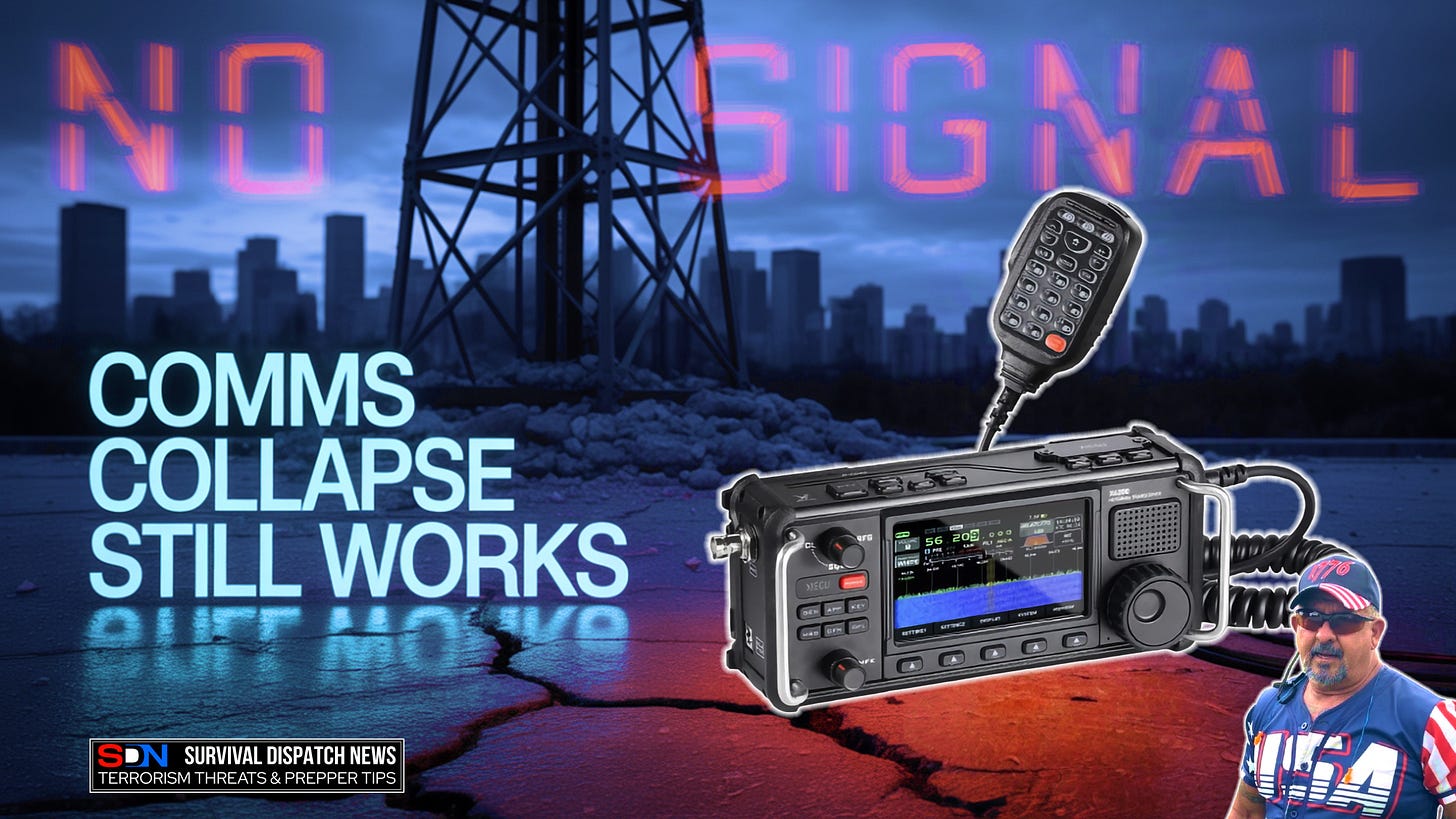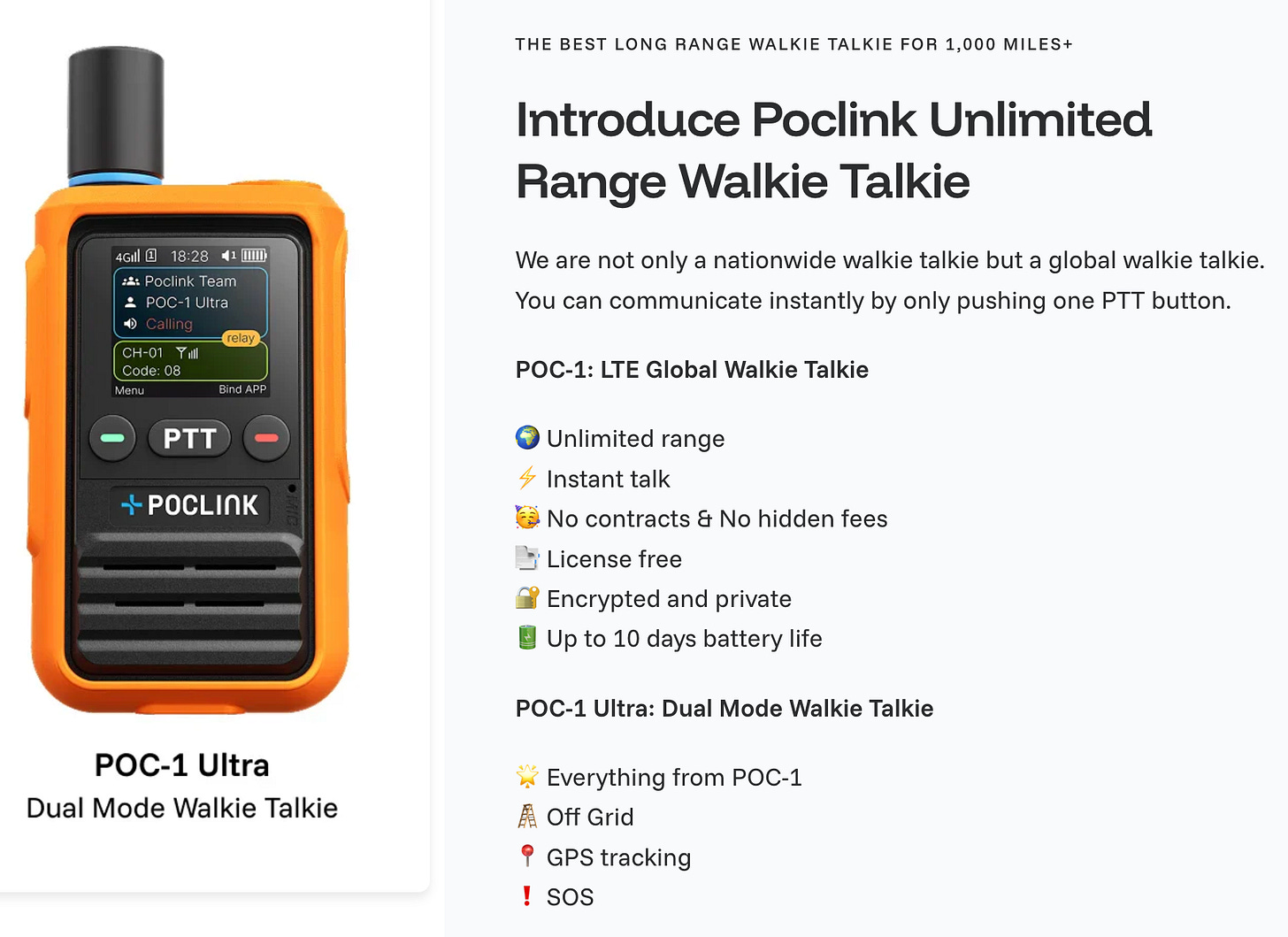Ranking the Best SHTF Comms Gear [2025 Update]
Survival Dispatch Field Report
This article is a follow-up to our last comms breakdown video and article: Best Survival Radios for Emergencies
For more than two years, we’ve been testing, breaking, and field-proving modern comms gear - most of it purchased out of our own pockets. From shortwave rigs and portable antennas to sat-linked messengers and LTE-driven radios, our goal has always been simple: find what actually works when the grid doesn’t.
Here’s the hard truth: in a true TEOTWAWKI / “Walking Dead” scenario, consumer gear gets exposed fast. Range collapses, infrastructure fails, batteries die, and marketing hype evaporates. What follows are our hard-earned rankings - what we trust, what we don’t, and what’s next in our field testing lineup.
Keep reading below ...
DISCLOSURE: This post contains affiliate links. If you make a purchase through them, we may earn a small commission at no extra cost to you. This helps keep our work independent. Thank you for your support.
#1 – Shortwave / HF Radio Systems [Xiegu, ICOM, Yaesu, etc.]
When civilization cracks, shortwave HF becomes king. It’s the only practical way to communicate hundreds - or even thousands - of miles without relying on towers, repeaters, or satellites. Even an entry-level rig like the Xiegu G90 HERE or X6200 HERE paired with a decent portable antenna runs $800 to $1,200 for a minimal setup, but it’s worth every penny when nothing else reaches out.
Pros
Global reach under the right conditions, continent-to-continent comms possible
Fully independent of infrastructure or paid networks
Voice, data, and digital mode capable
Extremely versatile: mobile, base, or field-deployable
Legal for emergency use worldwide
Cons
Expensive startup cost [rig + tuner + antenna + power + cables ≈ $800–$1,200]
Steep learning curve: you’ll need to understand propagation, tuning, grounding, and power management
Bulky compared to handheld or sat devices
Requires a reliable power source [solar or battery bank]
Bottom Line: The ultimate post-collapse comms solution - but it demands time, skill, and gear discipline.
Keep reading below ...
#2 – Iridium Satellite Devices [Garmin inReach Mini 2 & Messenger]
Mini 2 – Amazon link • Messenger – Amazon link
The Iridium satellite network is the most robust low-earth-orbit constellation in the world. Garmin’s compact messengers - particularly the inReach Mini 2 (~$400 or less on sale) and inReach Messenger (~$300 or less) - are unbeatable for two-way text comms, location sharing, and SOS signaling anywhere on Earth.
Pros
Global two-way messaging even without cell service
Built-in SOS via GEOS emergency center
Compact, rugged, waterproof, and proven
Bluetooth pairing with phones for easier texting
Battery life measured in days, not hours
Cons
Requires monthly subscription [$15–$50 depending on plan]
Text only, no voice or high-speed data
Limited message length
Slow for back-and-forth conversation
Bottom Line: The best “lifeline in your pocket.” Reliable, portable, and proven for off-grid teams and travelers.
If this information helps you, please consider a paid subscription …
#3 – Starlink Connectivity Systems [Starlink Internet + T-Mobile Satellite Text Add-Ons]
Starlink’s expanding satellite internet mesh has changed the survival-comms landscape. For stationary bases, vehicles, or homesteads, Starlink Residential or Starlink Roam provides broadband-level connectivity even in remote areas. And for mobile users, T-Mobile’s satellite texting - leveraging the same network - extends basic comms to smartphones.
Pros
High-speed internet anywhere with clear sky view
Supports full comms stack: VoIP, email, maps, video, data sync
Increasing coverage and stability
Starlink Roam kit [~$400 equipment + $150/mo unlimited service) still affordable compared to legacy sat-networks
Cons
Requires power & line-of-sight to sky
Not easily portable for hikers or evac teams
Dependent on SpaceX infrastructure [could be throttled or geo-restricted]
Subscriptions required
Bottom Line: Ideal for fixed locations or vehicle-based operations. Combine with handheld comms for redundancy.
#4 – LTE / FRS Hybrid Radios [POC Link Ultra]
Available here for $399/pair intro price - expected to rise to $1,140/pair.
Buy now and lock in lifetime global network access; later buyers will pay $29–$65 per radio per year.
These hybrid LTE radios operate anywhere there’s cellular service - without needing a phone. Think of them as global walkie-talkies over LTE + Wi-Fi. We’ve used the POC Link Ultra for real-time group coordination between Florida, Idaho, and Texas.
Pros
Push-to-talk anywhere LTE or Wi-Fi exists
Instant group or private channels worldwide
Encrypted digital comms
Simple interface - no ham license or setup required
No recurring fees during the intro promo
Cons
Useless in dead-zone/no-signal areas
Latency higher than radio but lower than cell call
Requires charging daily under heavy use
Future SIM fees will add cost for late adopters
Bottom Line: For networked teams or families spread across cities or states, nothing beats these for speed and ease - until the LTE network drops.
Click HERE, or the image below to get the POC-1 Ultras for only $399 for two radios and no annual fee for LTE network service for the life of the radios. This price is only for the first 1,000 units sold. After that they’ll be $1,140 a pair, and $29 to $65 a year for LTE service.
Keep reading below …
#5 – Licensed Business-Class Radios [Motorola & Kenwood]
Available at BuyTwoWayRadios.com
These are professional-grade encrypted radios used by security, logistics, and convoy operations. Licensing isn’t cheap, but you’ll receive dedicated frequencies and protection from interference.
Pros
FCC-licensed frequencies - exclusive within ≈ 50 mi radius
Secure comms with encryption and channel hopping
Outstanding clarity and durability
No dependency on towers or internet
Excellent vendor support from BuyTwoWayRadios
Cons
License cost ≈ $600–$1,200 plus application process
Limited to licensed geographic area
Shorter range than HF or satellite (5–20 miles typical)
Requires programming / radio management skills
Bottom Line: Superb for secure local ops - convoys, compounds, or team-based missions. Not for long-range work.
#6 – HAM / GMRS / FRS Radios
Also available via BuyTwoWayRadios.com
These are the gateway drugs of the comms world - Baofengs, Wouxuns, Midlands, and similar. They’re great training tools but underperform in real conditions unless supported by repeater networks or optimal terrain.
Pros
Cheap and widely available
Legal for most users with minimal licensing (GMRS = $35/10 yrs for family)
Excellent for local community networks and practice
Thousands of accessories, antennas, and mods
Great for listening in on others during SHTF
Cons
Real-world range ≈ 1–2 mi urban / 10 mi open terrain
Repeater-dependent for longer distances
Poor penetration in buildings and forested terrain
Quality varies drastically across brands
No encryption; open to eavesdropping
Bottom Line: Best entry-level training platform, but don’t bet your life on them when the grid goes dark.
If this information helps you, please consider a paid subscription …
Coming Next: The Xiegu Field Test
Our next video will dive deep into the Xiegu HF ecosystem - gear we purchased 100% out-of-pocket to give you an honest, real-world evaluation. We’ll cover the G90, X6200, the XPA125B 100 W amp, plus multiple portable antenna systems. The mission: prove that you can build an HF comms setup capable of covering the entire lower 48 states - and much of the world - without breaking the bank.
We’ll compare signal reports, antenna configurations, and performance between static base and mobile deployments, so you can make informed choices before investing.
Until then - train with what you have, learn what you can, and remember: comms fail last when you plan first.
Godspeed,
Chris Heaven, CEO
Survival Dispatch






Wish I had a friend like you here in AZ, THX brother.